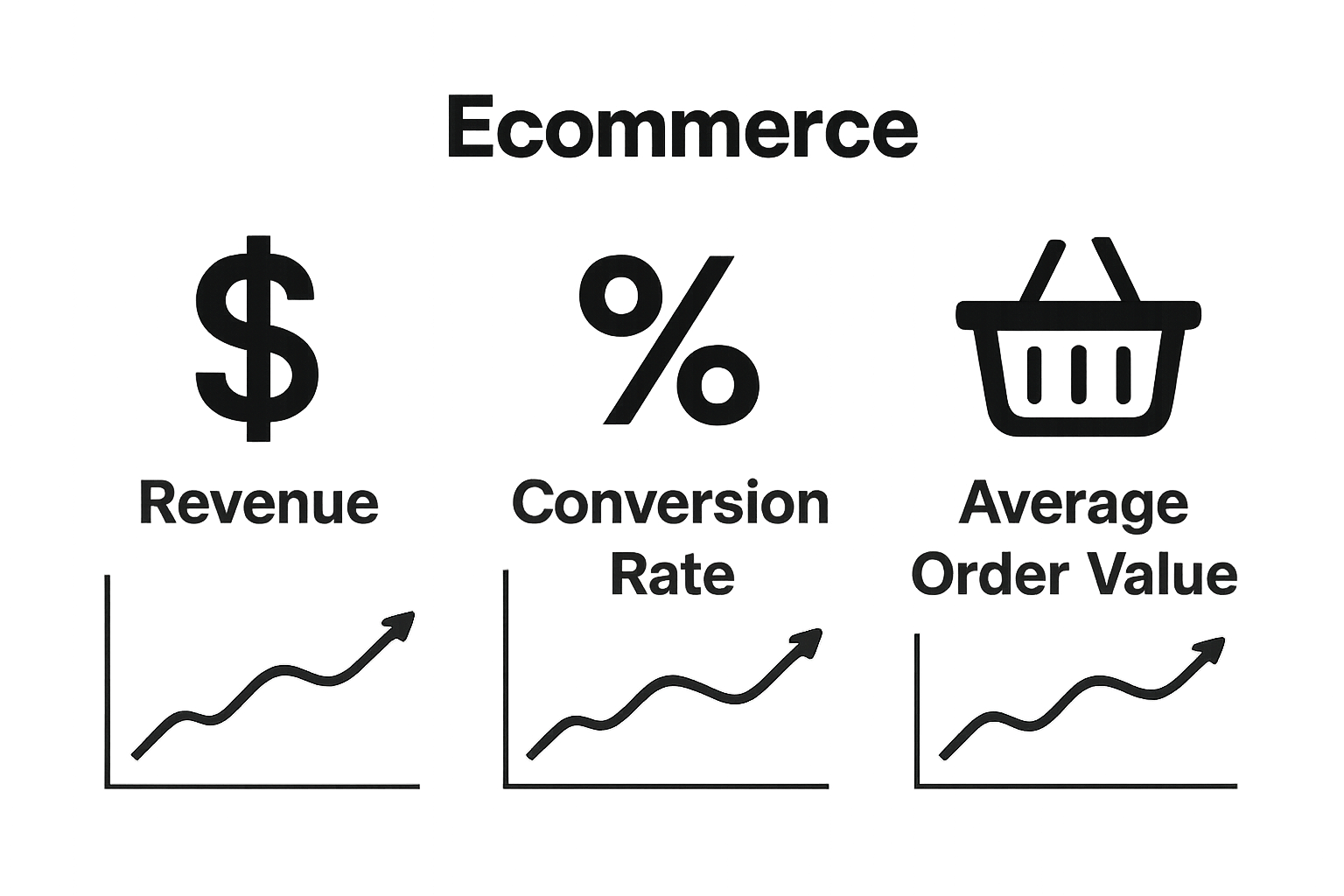
Online stores generate mountains of sales data every day, but finding meaning in those numbers is a challenge. Most business owners guess which products perform best or what drives a customer to finally click purchase. Here is the surprising part. With Google Analytics Ecommerce, you can go past surface numbers and unlock deep insights into your store’s performance, customer paths, and revenue streams. In fact, this system can show you the exact route each shopper takes before a buy and reveal which marketing channels actually produce revenue. The real breakthrough is how it turns raw sales data into a playbook for smarter business decisions.
Table of Contents
- What Is Google Analytics Ecommerce And Why It Matters
- Key Concepts Of Google Analytics Ecommerce Tracking
- How Google Analytics Ecommerce Provides Insights
- Interpreting Data From Google Analytics Ecommerce
- Real-World Applications Of Google Analytics Ecommerce
Quick Summary
| Takeaway | Explanation |
|---|---|
| Track customer journeys effectively | Google Analytics Ecommerce helps merchants analyze detailed paths customers take before making purchases, enhancing understanding of user experience. |
| Leverage actionable data insights | The platform turns complex data into strategic intelligence, guiding inventory management, marketing strategies, and product positioning. |
| Optimize marketing campaigns | By identifying effective traffic sources and customer preferences, businesses can create targeted marketing campaigns that drive conversions. |
| Identify performance metrics | Key metrics like conversion rates and average order value provide insights into sales performance, assisting in data-driven decision making. |
| Enhance operational efficiency | Utilize insights to minimize cart abandonment, optimize product placement, and improve overall user experience on your online store. |
What is Google Analytics Ecommerce and Why It Matters
Google Analytics Ecommerce is a robust tracking system designed specifically for online stores to transform raw sales data into actionable business intelligence. This powerful tool goes beyond traditional web analytics by providing deep insights into your store’s performance, customer behavior, and revenue generation strategies.
Understanding the Fundamentals
At its core, Google Analytics Ecommerce enables merchants to track and analyze critical metrics that reveal the complete customer purchasing journey. Learn more about retail analytics terms to enhance your understanding of these complex measurement techniques.
The platform captures detailed information about every transaction, including:
- Total revenue generated
- Number of transactions
- Average order value
- Product performance
- Customer purchasing patterns
Why Ecommerce Analytics Matter
According to research from the Stanford Institute for Economic Policy Research, understanding digital sales metrics is crucial for modern businesses. Google Analytics Ecommerce provides merchants with unprecedented visibility into their online store’s performance.
By tracking granular data points, you can make informed decisions about inventory management, marketing strategies, and product positioning. The tool helps you understand not just what customers are buying, but how they are navigating your online store before making a purchase.
Unlike generic web analytics, ecommerce tracking offers a comprehensive view of your sales funnel. It connects website traffic, user behavior, and actual revenue generation, giving you a holistic perspective on your digital business performance. This means you can pinpoint exactly which marketing channels, products, and customer segments are driving the most value for your online store.
Key Concepts of Google Analytics Ecommerce Tracking
Google Analytics Ecommerce tracking is a sophisticated system that transforms complex digital interactions into meaningful business insights. By capturing intricate details about customer behavior and transaction patterns, this tool provides online merchants with a comprehensive understanding of their digital sales ecosystem.
Essential Tracking Metrics
The core of Google Analytics Ecommerce tracking revolves around several fundamental metrics that paint a holistic picture of your online store’s performance. Explore how sales data drives marketing strategies to gain deeper insights into these critical measurements.
Key metrics that define your store’s digital performance include:
Below is a table summarizing the essential tracking metrics that Google Analytics Ecommerce provides, clarifying how each metric supports online store performance analysis.
| Metric | Description |
|---|---|
| Transaction Data | Details of each purchase including items, quantity, and value |
| Revenue Tracking | Tracks total sales, individual product revenue, and order sales |
| Customer Journey Mapping | Maps customer paths from initial visit to purchase |
| Product Performance | Analyzes which products generate the highest and lowest revenue |
| Conversion Rates | Measures the percentage of visitors who complete a purchase |

- Transaction Data: Complete details of each purchase
- Revenue Tracking: Precise calculation of total sales and individual product revenues
- Customer Journey Mapping: Detailed path from initial website visit to final purchase
- Product Performance: Insights into which products drive most revenue
- Conversion Rates: Percentage of visitors who complete a purchase
Advanced Tracking Capabilities
According to research from the Ohio State University’s Office of Marketing and Communications, advanced Google Analytics features go beyond basic transaction tracking. The platform enables merchants to understand not just what was purchased, but how customers interact with their online store before making a purchase.
The tracking system captures nuanced behavioral data such as time spent on product pages, click paths, and abandoned cart information. This granular approach allows online stores to create targeted marketing strategies, optimize user experience, and identify potential friction points in the purchasing process.
By integrating transaction data with user behavior analytics, Google Analytics Ecommerce provides a 360-degree view of your online business performance. This comprehensive approach empowers store owners to make data-driven decisions that can significantly improve sales, customer satisfaction, and overall digital strategy.
How Google Analytics Ecommerce Provides Insights
Google Analytics Ecommerce transforms raw data into strategic intelligence, offering online store owners a powerful lens into their digital business performance. By converting complex user interactions and transaction details into actionable insights, this tool becomes an indispensable resource for strategic decision making.
Decoding Customer Behavior Patterns
Explore advanced marketplace analytics strategies to understand how data interpretation drives business growth. The platform reveals intricate details about customer journeys, helping merchants understand the nuanced paths customers take before making a purchase.
Key behavioral insights include:
- Purchase Triggers: Identifying specific actions that lead to conversions
- Navigation Patterns: Understanding how customers move through your online store
- Engagement Metrics: Measuring time spent on product pages and interaction levels
- Friction Points: Detecting where potential customers might abandon their shopping process
- Demographic Insights: Understanding customer segments and their purchasing behaviors
Transforming Data into Strategic Opportunities
According to research from the Stanford Institute for Economic Policy Research, understanding digital sales metrics is crucial for modern businesses. Google Analytics Ecommerce goes beyond simple number tracking by providing predictive and prescriptive analytics.
The platform enables merchants to:
- Optimize product placement
- Develop targeted marketing campaigns
- Personalize customer experiences
- Forecast potential revenue streams
- Identify high performing and underperforming product lines
By synthesizing complex data points into clear, actionable recommendations, Google Analytics Ecommerce empowers online store owners to make informed, data driven decisions. The tool does not just report past performance but provides strategic insights that can proactively shape future business strategies.
Interpreting Data from Google Analytics Ecommerce
Understanding the rich data landscape generated by Google Analytics Ecommerce requires a strategic approach to interpretation. Merchants must move beyond surface-level numbers to extract meaningful insights that drive business growth and optimize online sales strategies.
Decoding Critical Performance Indicators
Learn about AI-powered market basket analysis to enhance your understanding of advanced data interpretation techniques. Successful data analysis involves understanding the interconnected nature of various performance metrics and their implications for your online store.
Key performance indicators merchants should focus on include:
This table breaks down critical performance indicators tracked by Google Analytics Ecommerce, offering clear definitions to help merchants interpret and act on their store metrics.
| Performance Indicator | What It Measures |
|---|---|
| Conversion Rate | Percentage of visitors who complete a purchase |
| Average Order Value | Total revenue divided by number of transactions |
| Revenue per Session | Revenue generated per website visit |
| Cart Abandonment Rate | Percentage of carts abandoned before purchase |
| Customer Lifetime Value | Projected total revenue from a single customer |

- Conversion Rate: Percentage of visitors completing a purchase
- Average Order Value: Total revenue divided by number of transactions
- Revenue per Session: Financial performance per website visitor
- Cart Abandonment Rate: Percentage of initiated purchases not completed
- Customer Lifetime Value: Predicted total revenue from a single customer
Translating Data into Actionable Strategies
According to research published in the National Center for Biotechnology Information, effective eCommerce analytics require a systematic approach to data interpretation. Google Analytics Ecommerce provides comprehensive data visualization that transforms complex metrics into understandable insights.
Effective data interpretation involves:
- Identifying trends and patterns in customer behavior
- Recognizing high performing and underperforming product categories
- Understanding traffic source effectiveness
- Evaluating marketing campaign performance
- Detecting potential areas for website optimization
The true power of Google Analytics Ecommerce lies not just in collecting data, but in transforming raw numbers into strategic business intelligence. By developing a nuanced understanding of these metrics, online store owners can make precise, data driven decisions that directly impact revenue and customer satisfaction.
Real-World Applications of Google Analytics Ecommerce
Google Analytics Ecommerce transcends theoretical data analysis by offering tangible, practical applications that directly impact business performance. Online merchants can leverage these insights to make strategic decisions that transform digital sales strategies and enhance overall business growth.
Strategic Marketing and Customer Acquisition
Explore advanced market basket analytics strategies to understand how data-driven insights can revolutionize marketing approaches. The platform enables businesses to develop precision-targeted marketing campaigns that speak directly to customer preferences and behavioral patterns.
Practical marketing applications include:
- Creating personalized remarketing campaigns
- Identifying most effective traffic sources
- Segmenting audiences based on purchasing behavior
- Developing targeted promotional strategies
- Allocating marketing budget more efficiently
Operational Optimization and Revenue Enhancement
According to research analyzing the Google Merchandise Store, Google Analytics Ecommerce provides comprehensive insights that go beyond traditional performance tracking. The tool enables businesses to surgically optimize their online operations and revenue generation strategies.
Real-world operational improvements include:
- Identifying and reducing cart abandonment rates
- Optimizing product placement and pricing strategies
- Understanding customer purchase journeys
- Detecting potential website user experience issues
- Forecasting inventory and demand requirements
By transforming raw data into actionable intelligence, Google Analytics Ecommerce empowers online store owners to make informed, strategic decisions. The platform serves not just as a reporting tool, but as a comprehensive business intelligence system that provides a competitive edge in the rapidly evolving digital marketplace.
Unlock Actionable Revenue Opportunities Hidden in Your Google Analytics Ecommerce Data
Are you frustrated by simply tracking your online sales and customer behavior, but still feel unsure how to use these insights to actually increase your store’s revenue? If the terms conversion rate, cart abandonment, and product performance from the article resonate with your challenges, you are not alone. Many Shopify and WooCommerce merchants want to move beyond surface-level reporting to truly actionable steps that grow their business.

Experience what happens when you turn your Google Analytics Ecommerce data into real revenue growth. APUS NEST lets you upload your sales data and reveals product combinations and cross-sell opportunities that boost your average order value. Get a free report or upgrade for a detailed roadmap tailored to your business. Act now and see how APUS NEST empowers you to use advanced market basket analysis for smarter product placement and marketing strategies. Do not just review your ecommerce analytics. Transform them into extra profit today.
Frequently Asked Questions
What is Google Analytics Ecommerce and how does it work?
Google Analytics Ecommerce is a tracking system designed for online stores to analyze sales data, customer behavior, and revenue insights. It captures detailed information about transactions, including total revenue, number of transactions, and average order value, allowing merchants to understand customer purchasing journeys.
Why should online stores use Google Analytics Ecommerce tracking?
Using Google Analytics Ecommerce tracking provides critical insights into store performance and customer behavior. It helps merchants make informed decisions regarding inventory management, marketing strategies, and product positioning by analyzing granular data points related to the sales funnel.
What key metrics can I track with Google Analytics Ecommerce?
Key metrics you can track include transaction data, revenue tracking, customer journey mapping, product performance, and conversion rates. These metrics give a comprehensive view of how your online store is performing and how customers interact with your site.
How can Google Analytics Ecommerce help improve my digital marketing strategies?
Google Analytics Ecommerce can enhance your marketing strategies by identifying purchase triggers, understanding navigation patterns, and detecting friction points that may hinder conversions. By utilizing actionable insights from the data collected, you can create targeted marketing campaigns and optimize customer experiences.
Recommended
- Understanding Top Retail Analytics Terms for E-Commerce Success - ApusNest Blog | ApusNest
- Understanding the Role of Sales Data in Marketing - ApusNest Blog | ApusNest
- Free WooCommerce Order Exporter Plugin - ApusNest
- Marketplace Analytics Guide: Unlock Growth in 2025 - ApusNest Blog | ApusNest
- Track LLM Traffic in Google Analytics 4 (GA4)